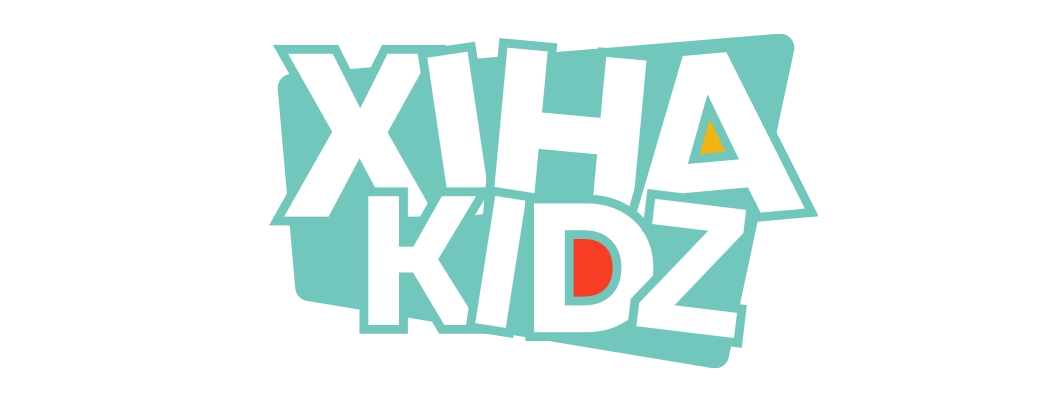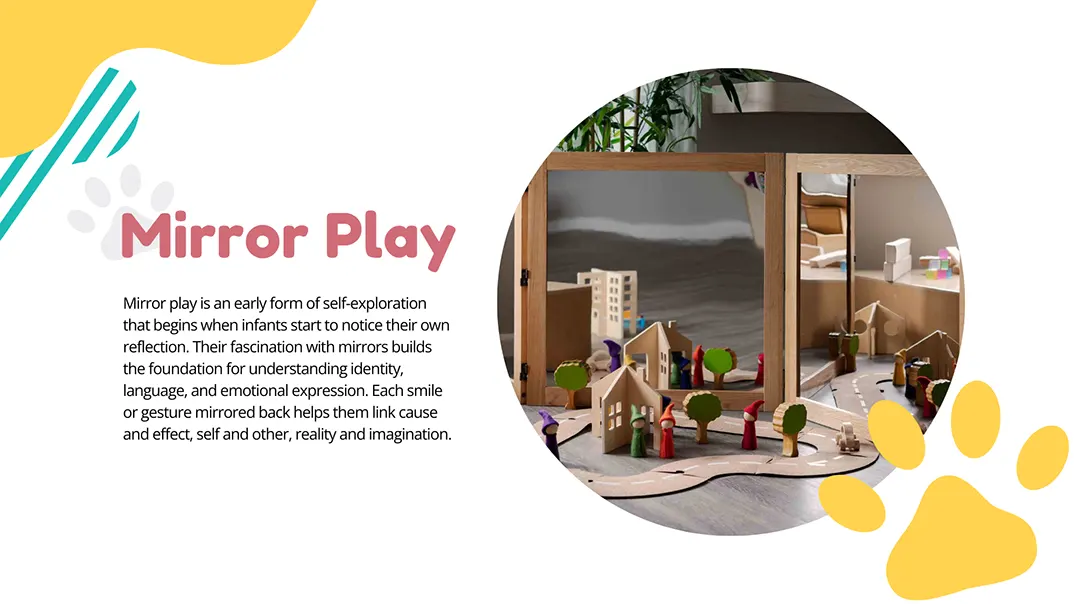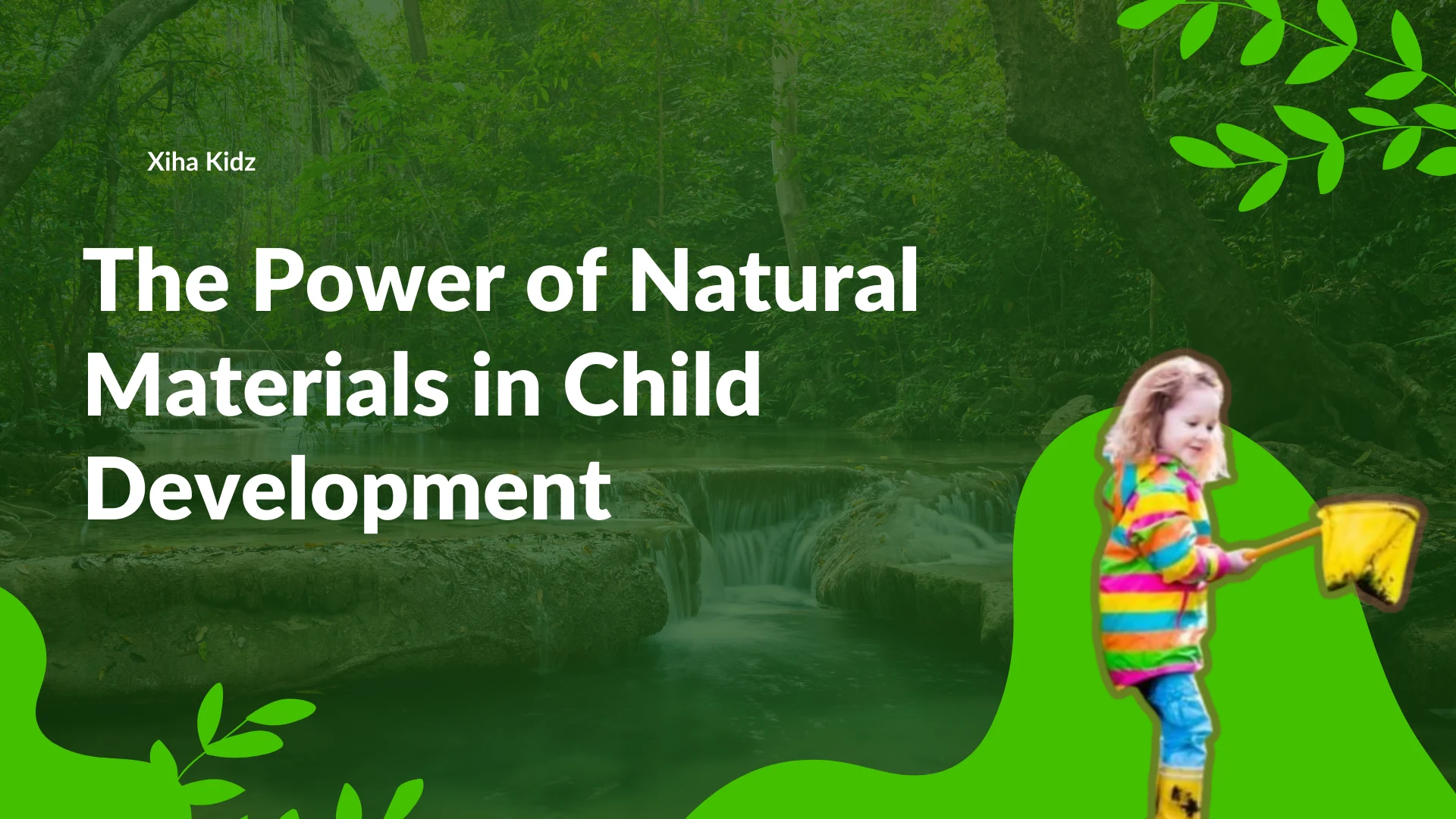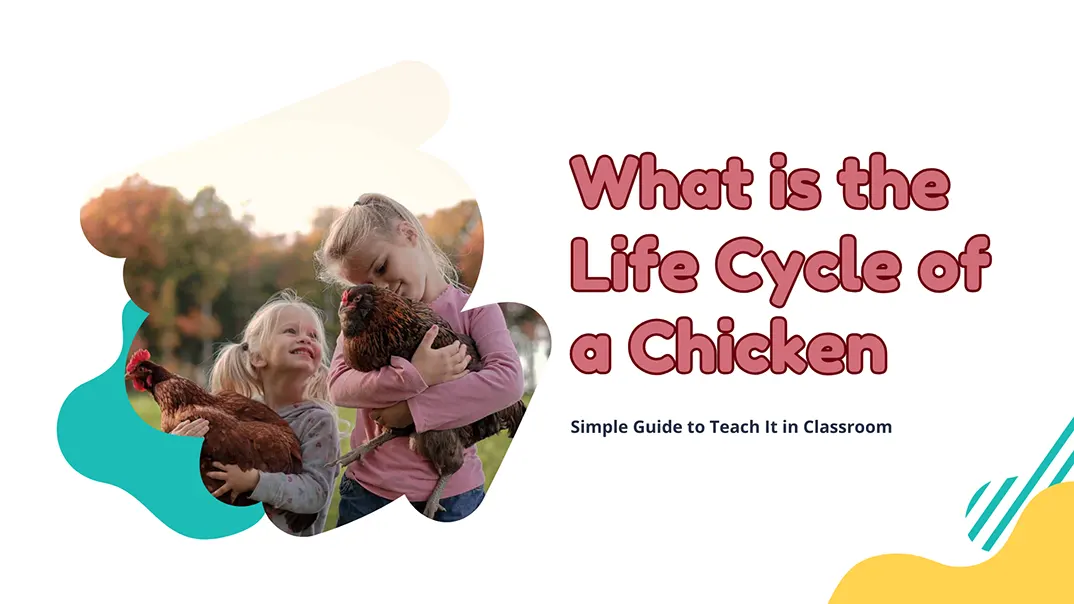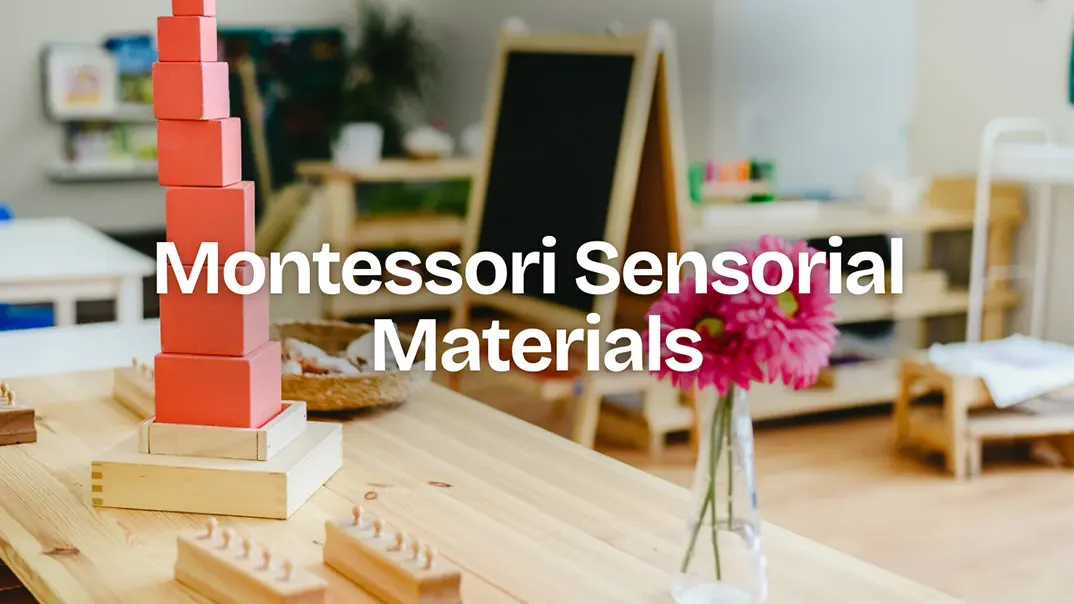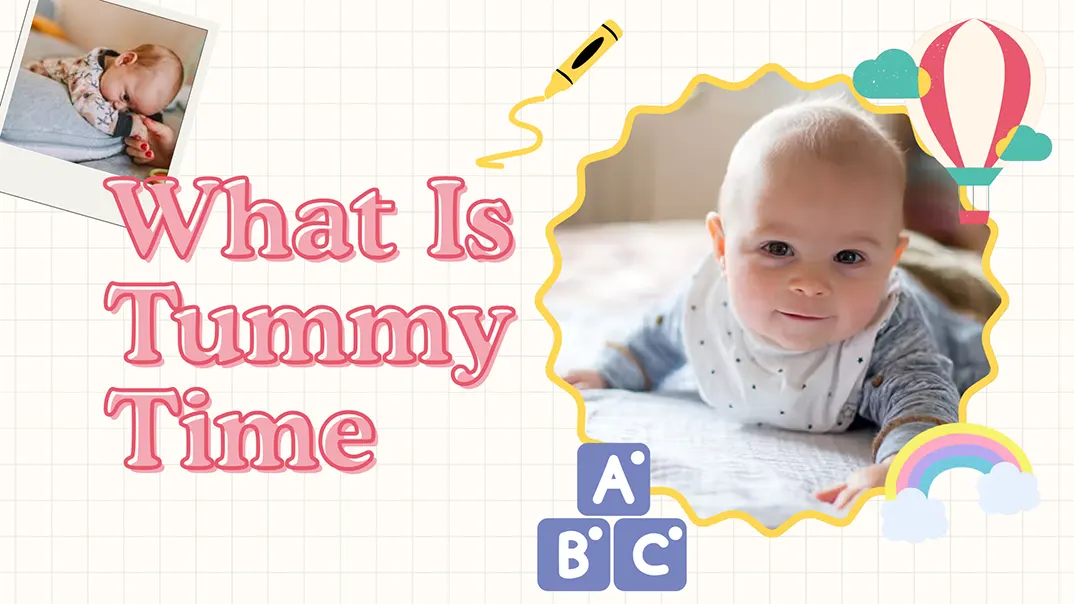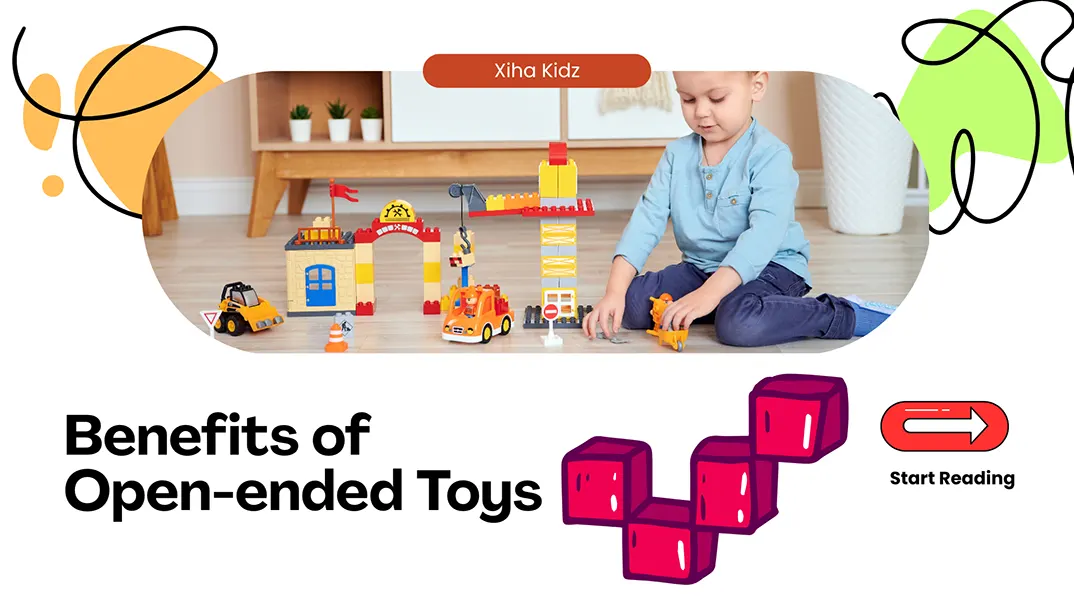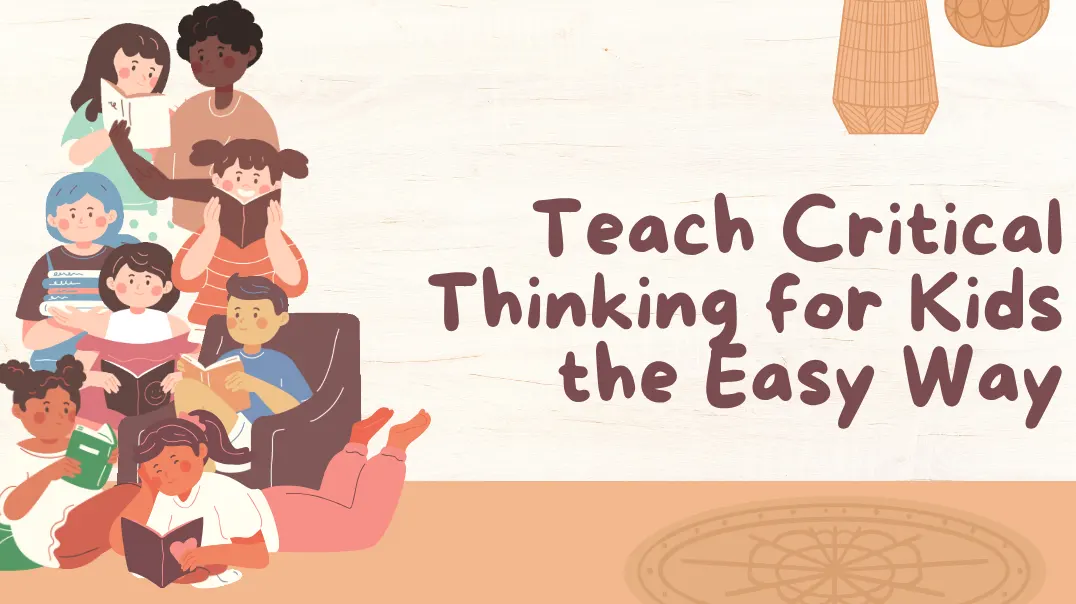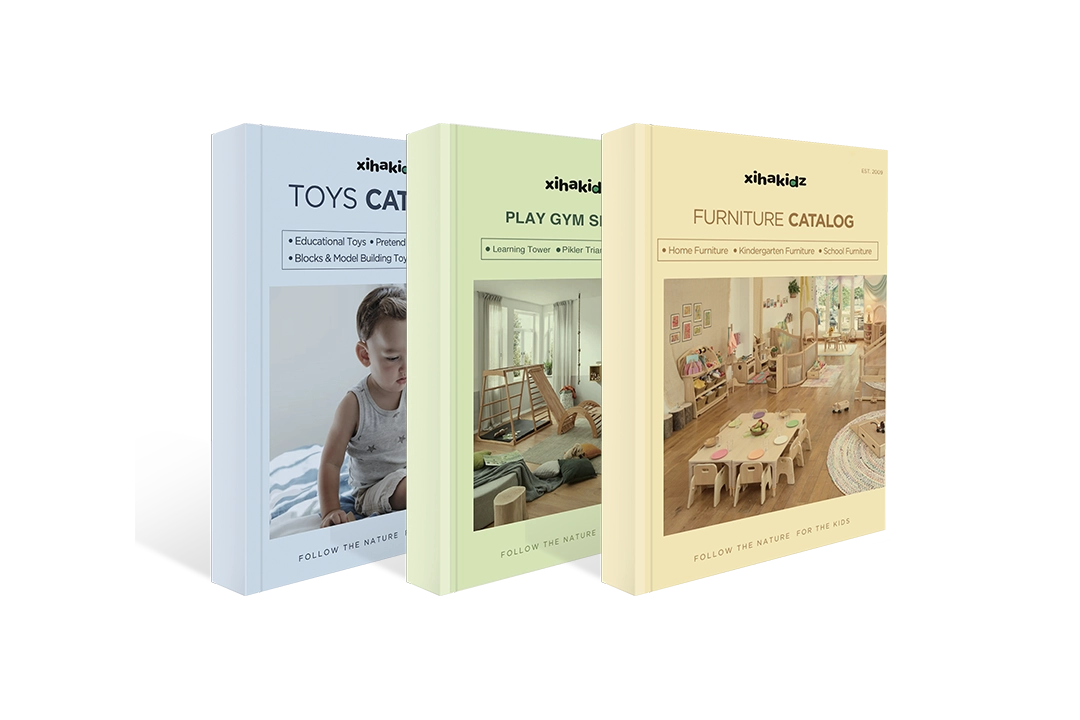Imagine a toddler laughing at her reflection, waving her hands as if greeting a new friend. That simple moment is the heart of mirror play, a natural behavior that reveals how children learn about themselves and others.
From birth, children are drawn to faces and motion. Their fascination with mirrors builds the foundation for understanding identity, language, and emotional expression. Each smile or gesture mirrored back helps them link cause and effect, self and other, reality and imagination.
In this article, we will explore what mirror play really means, why it matters in early learning, and how to introduce it effectively in classrooms and homes. By setting up safe, inviting spaces and guiding mirror play activities, we can inspire confidence, empathy, and curiosity in every child’s early learning journey.
What Is Mirror Play?
Mirror play is an early form of self-exploration that begins when infants start to notice their own reflection. At first, children see a moving image without understanding that it is themselves. Over time, they begin to connect their gestures, facial expressions, and emotions with what they see in the mirror. This process transforms simple fascination into a powerful learning experience that supports both cognitive and emotional development.
From an educational perspective, mirror play is defined as a sensory and observational experience that connects perception with movement. When children look into a mirror, they encounter a dynamic image that reacts immediately to their gestures. This immediate feedback encourages curiosity and repetition, allowing children to test visual relationships such as symmetry, direction, and proportion.
Developmental Theories Behind Mirror Play
The concept of the mirror stage was introduced by psychoanalyst Jacques Lacan. It describes the period, usually between 6 and 18 months of age, when infants first recognize their reflection as themselves. This recognition marks an early step in developing self-awareness and identity.
Modern neuroscience identifies a group of brain cells called mirror neurons that activate both when a person performs an action and when they observe the same action. This system helps explain why observing one’s own reflection can reinforce understanding of movement and expression.
Key Developmental Skills Supported by Mirror Play
Mirror play plays an important role in early childhood development, helping children make meaningful connections between what they see, feel, and do. Through looking at their reflections, young learners begin to build awareness, coordination, and understanding of both themselves and the world around them.
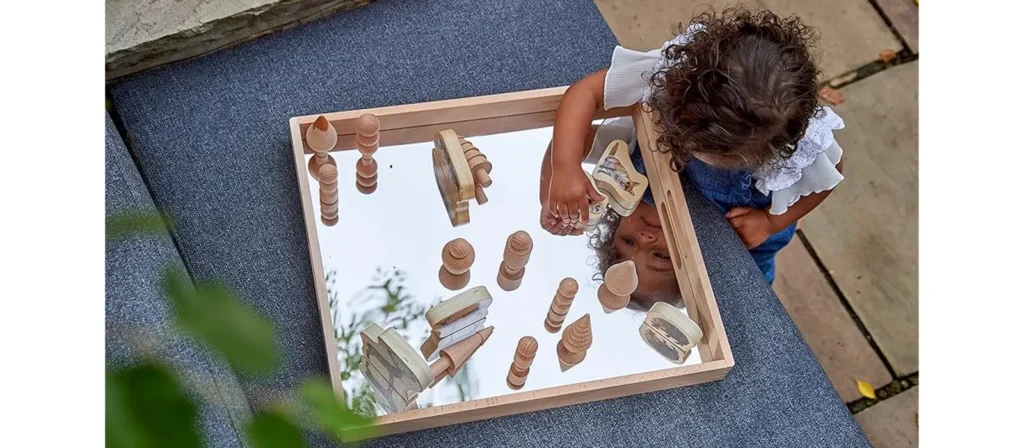
1. Object Permanence and Memory
Mirrors support the development of object permanence, the understanding that objects and people still exist even when they are not visible. As children move away from a mirror and return to see their reflection again, they strengthen their sense of continuity and memory. These early thought patterns support logical thinking and problem-solving skills as children grow.
2. Self-Awareness
Mirror play helps children gradually develop the understanding that they are separate individuals. By observing their reflections, infants start to recognize their own movements, gestures, and facial expressions. This process marks the beginning of self-recognition, which typically appears during the second year of life. As children connect their image with their physical body, they begin to develop confidence and an emerging sense of identity.
The Rouge Test
One well-known way to observe the development of self-awareness in young children is through the rouge test. In this simple experiment, a small mark of red lipstick or colored cream is gently placed on the child’s forehead without their knowledge. The child is then positioned in front of a mirror. If the child reaches up to touch their own forehead, rather than the mirror image, it suggests that they recognize the reflection as themselves. This reaction typically begins to appear between 18 and 24 months of age and is seen as an early sign of self-recognition.The rouge test is often used by developmental psychologists to study how children begin to understand the concept of “self” during the toddler years.
3. Spatial Awareness
As children explore their reflections, they naturally engage in movement and coordination. They might reach, wave, or bend toward the mirror, discovering how their body relates to space. These actions improve hand-eye coordination and body control, allowing children to gain a clearer sense of balance and positioning.
4. Emotional Understanding
Mirror play allows children to explore facial expressions and connect them with emotions. When they smile, frown, or show curiosity in front of a mirror, they begin to identify how emotions look and feel. This helps them label their own feelings and later recognize similar emotions in others, fostering empathy and emotional regulation.
5. Language and Communication Development
As children observe their mouths, eyes, and gestures while speaking or making sounds, they begin to connect language with physical expression. Caregivers can enhance this by talking about what they see together, naming emotions or actions, and encouraging imitation. This strengthens vocabulary, pronunciation, and social communication.
6. Physical and Motor Development
Mirror play naturally encourages both fine and gross motor skills. When infants reach toward their reflection, touch their faces, or clap their hands, they improve coordination and hand control. As children grow older, mirrors motivate them to move, dance, or imitate large body actions, strengthening muscles, balance, and overall body awareness.
قم بتحويل فصلك الدراسي باستخدام حلول الأثاث المخصصة
Mirror Play Milestones in Early Childhood
Mirror play develops gradually as children move from simple visual exploration to true self-recognition. Each stage reflects a new level of understanding, coordination, and awareness. Although individual progress may vary, most children follow a general sequence as they interact with their reflections.
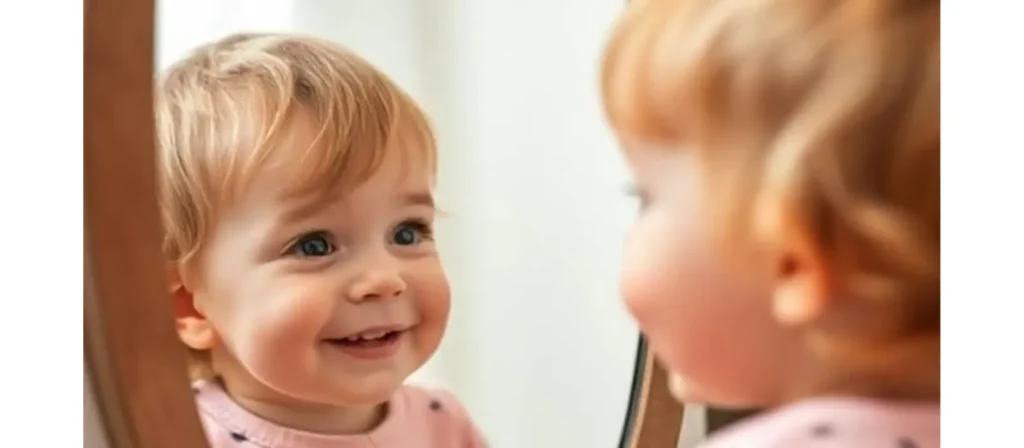
1. Infants (Birth to 6 Months)
At this stage, infants look at mirrors mainly because of their visual appeal. They are drawn to light, color, and movement. The reflection is seen as part of their environment rather than as themselves. Babies may stare at the image or move their arms and legs while watching the motion, showing curiosity but not recognition.
2. Older Infants (6 to 12 Months)
During this period, infants begin to react more actively to what they see. They may smile, reach toward the reflection, or make sounds at the image in the mirror. These behaviors indicate the early connection between visual feedback and self-generated movement. The reflection becomes interesting and familiar, though the child may still treat it as another person.
3. Toddlers (12 to 36 Months)
Between one and two years of age, many children begin to show signs of self-recognition. They may point to body parts in the mirror, look at their face with interest, or react to changes in their appearance. This is also when many children pass basic self-awareness tests, such as noticing a sticker or mark on their face and attempting to remove it.
4. Preschoolers (3 to 5 Years)
At this stage, self-recognition becomes secure and more complex. Children use mirrors not only to identify themselves but to explore emotions, movement, and appearance. They may use mirrors during pretend play, art, or dramatic expression. Mirror play now serves as a medium for creativity, emotional awareness, and social understanding.
Practical Tips for Parents and Teachers
Supporting mirror play requires more than simply placing a mirror in front of a child. Parents and teachers play a key role in shaping how children explore their reflections, from the mirrors they use to the spaces where play unfolds. By preparing safe environments, offering thoughtful guidance, and keeping activities age-appropriate, educators can transform simple reflection into powerful opportunities for learning and self-discovery.
1. Choosing the Right Mirror
Select mirrors that are safe, clear, and suitable for young children. Shatter-resistant acrylic or polycarbonate mirrors are ideal because they do not break easily and can be cleaned regularly. Avoid glass mirrors in play areas.
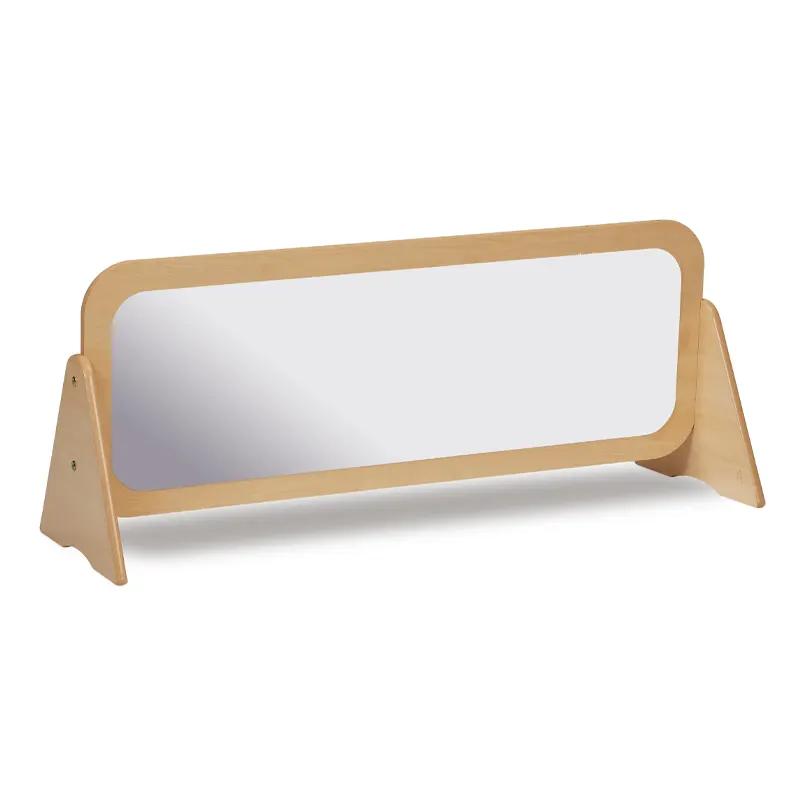
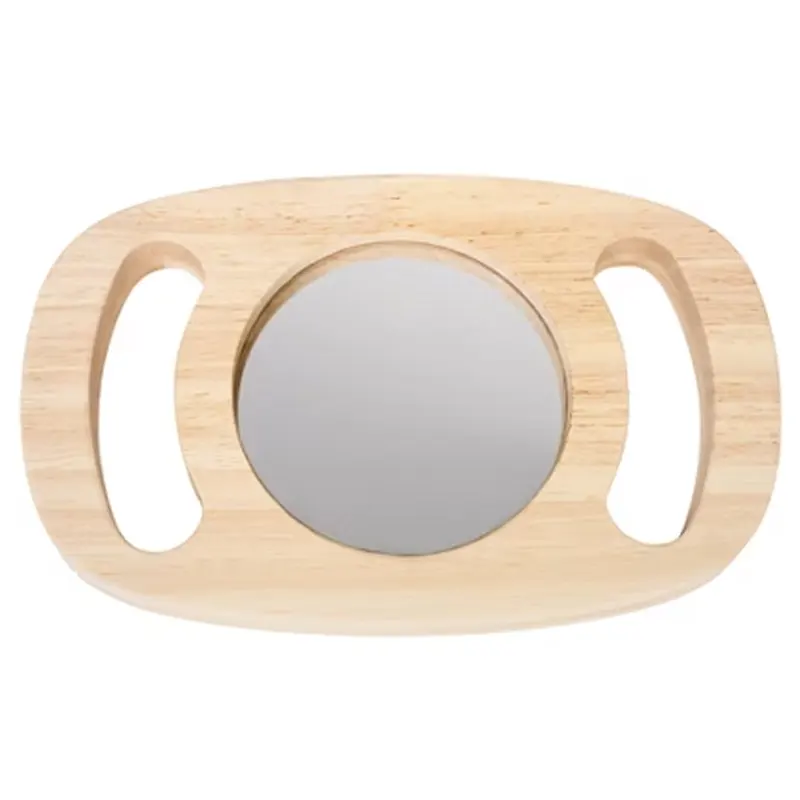
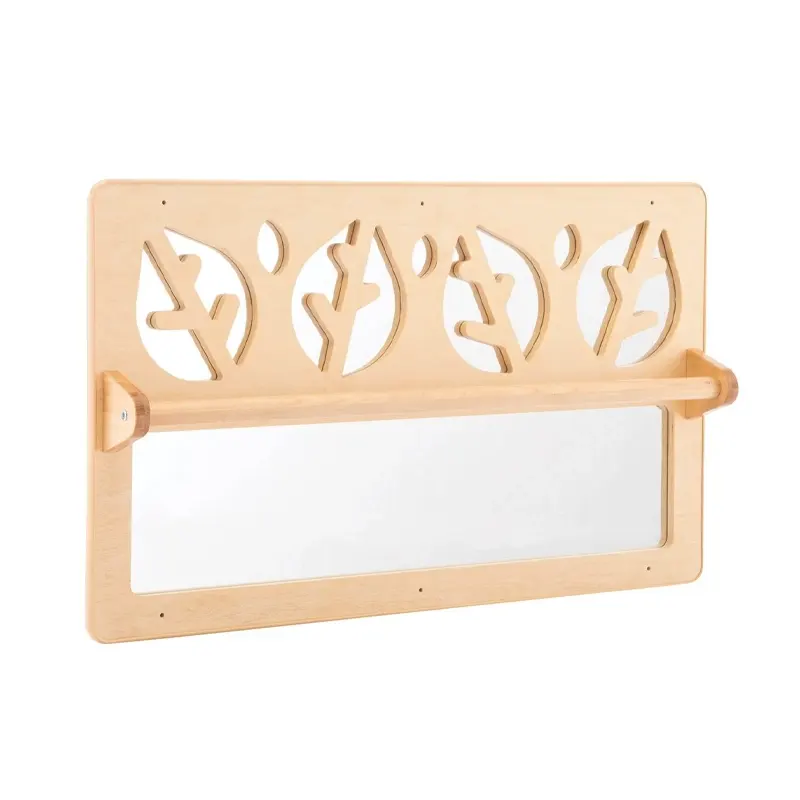
- Floor mirrors: Ideal for infants during tummy time or early crawling. They allow babies to observe movement and facial expressions at their level.
- Wall-mounted mirrors: Suitable for toddlers and preschoolers who can sit, stand, or move around while interacting with their reflections. These mirrors encourage independence and group exploration.
- Table mirrors: Perfect for art, science, or sensory centers in classrooms. They allow small groups to observe details, symmetry, or facial expressions during creative activities.
- Handheld mirrors: Best for one-on-one play or focused observation. Children can hold the mirror close to explore facial features, mouth movements, or emotional expressions.
اكتشف مجموعتنا الكاملة من المنتجات
احصل على إمكانية الوصول إلى كتالوجنا الشامل الذي يحتوي على أثاث ومعدات لعب عالية الجودة لرياض الأطفال والمدارس.
2. Create a Safe and Inviting Space
A well-prepared environment helps children explore confidently. Place mirrors at the child’s eye level so they can see themselves without strain. Ensure the play area is free from glare and distractions. Soft lighting, calm surroundings, and nearby open floor space make it easier for children to move and observe. Teachers can include mirrors in learning centers such as the art area, science corner, or dramatic play zone. At home, parents can integrate mirrors into daily spaces like bedrooms, bathrooms, or play corners.
3. Observe Rather Than Direct
Allow children to take the lead during mirror play. Watch how they respond to their reflection before giving instructions. This open-ended approach encourages curiosity, independence, and self-paced discovery. Gentle verbal cues such as “What do you see?” or “Can you make that face again?” can help extend engagement without taking control of the experience.
4. Integrating Mirrors Into Daily Routines
Mirror play should not be limited to special activities. Incorporate mirrors naturally into daily routines to promote awareness and independence. Mirrors can be used during dressing, handwashing, or brushing teeth. Teachers can include small mirrors in the classroom for children to observe themselves during art, music, or storytelling sessions. These small moments encourage children to connect self-recognition with everyday experiences.
5. Rotate Mirror Activities to Maintain Interest
Children learn best when play remains fresh and engaging. Over time, familiar mirror setups can lose their novelty, so rotating activities and materials helps sustain curiosity and discovery. Variety also allows children to explore different developmental skills while keeping mirror play a consistent part of their learning environment.
Begin by changing the focus or setting of mirror activities every few weeks. Move the mirror to a different part of the room or combine it with new materials such as dramatic play toys, building blocks, or art tools. For example, a floor mirror that was once used for movement games can later become part of a dramatic play corner where children explore facial expressions or pretend roles.
6. Observing Progress and Encouraging Confidence
Teachers and parents can use mirror play to observe developmental progress. Notice how children respond to their reflections, whether they smile, reach, imitate, or talk to the image. These small behaviors reveal growth in coordination, language, and self-awareness.
Adults should use positive and encouraging language during mirror play. Phrases such as “I like your smile” or “You are concentrating so well” help children develop confidence and a healthy sense of self.
7. Follow Basic Safety Practices
Always supervise young children during mirror play, especially when using handheld or freestanding mirrors. Check mirrors regularly for cracks, scratches, or wear. Avoid placing mirrors near sharp corners or unstable surfaces. Teach children to treat mirrors gently and with care.
Teach children simple mirror play rules to keep them safe and respectful:
- Use gentle hands when touching the mirror
- Keep the mirror on the floor or table, not in the air
- Look, smile, and move, but do not hit or throw the mirror
- Share the mirror with friends and take turns
- Ask an adult for help if the mirror feels loose or wobbly
Simple Mirror Play Activities
Mirror play does not require complex setups to be meaningful. Simple activities using everyday mirrors can spark curiosity, support development, and bring joy to young children. The following ideas are easy to implement at home or in the classroom and offer rich learning opportunities through play.
1. Playing with Mirrors During Tummy Time
Place a baby-safe floor mirror next to an infant during tummy time. The reflection captures the baby’s attention and motivates them to lift their head and upper body to look more closely. This natural curiosity makes tummy time more engaging and helps the baby begin recognizing movement, light, and faces.
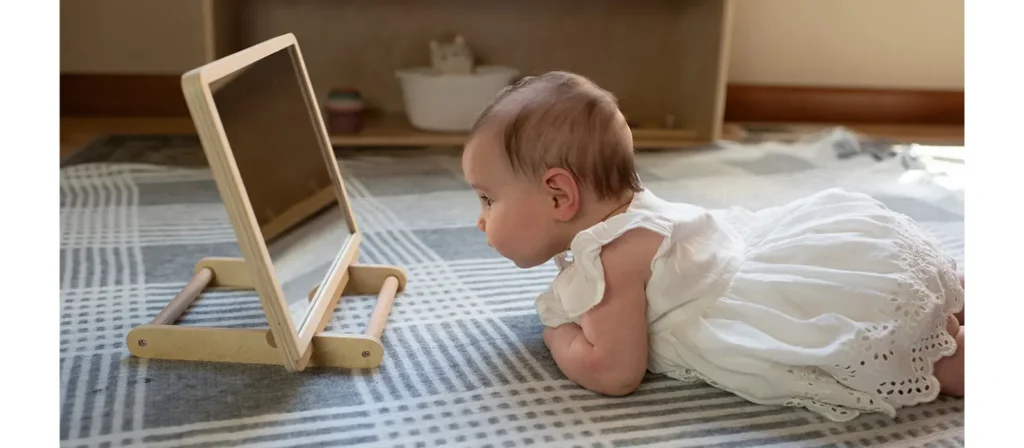
Steps
- Lay a soft blanket on the floor and place the infant on their tummy.
- Position a shatterproof floor mirror slightly to the side or in front of the baby.
- Sit nearby and talk, smile, or move gently to invite the baby’s attention to the mirror.
Benefits
- Encourages neck and upper body strength
- Promotes early visual tracking and focus
- Sparks early social interest and curiosity
قم بتحويل فصلك الدراسي باستخدام حلول الأثاث المخصصة
2. Mirror Movements
Invite children to move freely in front of a large mirror while paying attention to how their reflection follows them. Begin with simple actions such as lifting an arm, bending, or turning, and then add music to introduce rhythm and flow. The mirror helps children connect what they feel in their bodies with what they see, deepening their understanding of movement and space.
Steps
- Clear a safe space with a full-length or wall-mounted mirror.
- Ask the child to make slow, gentle movements while watching their reflection.
- Add background music and encourage expressive movement.
- Conclude with a calm stretch and reflection on how their body felt.
Benefits
- Improves balance, coordination, and spatial awareness.
- Strengthens focus and self-regulation through controlled movement.
- Promotes confidence and joy in physical expression.
3. Copy My Face
Sit beside a child in front of a mirror and make different facial expressions together. Begin with simple ones such as smiling, frowning, or opening your mouth wide. As the child gains confidence, invite them to invent their own expressions while you copy them. The mirror becomes a playful tool for learning how faces show feelings and for building connections through imitation.
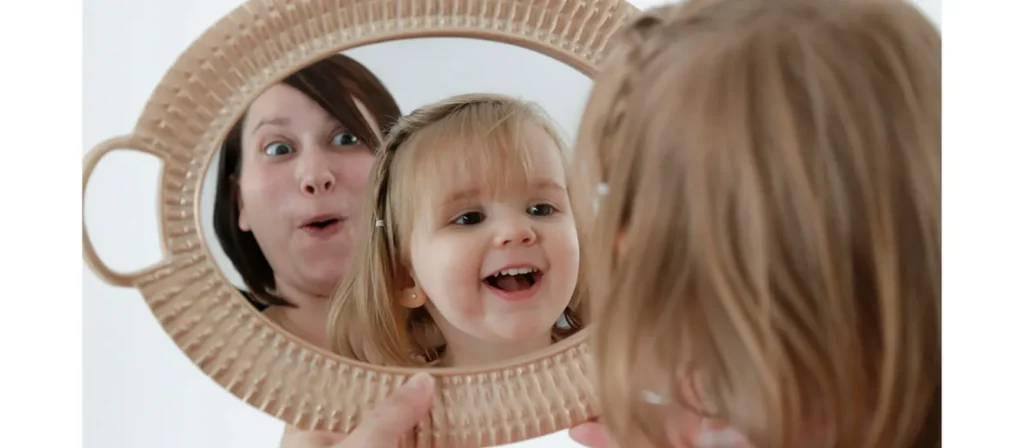
Steps
- Sit comfortably with the child facing the mirror.
- Model one expression and ask the child to copy it.
- Switch roles so the child makes a face for you to imitate.
- Talk about what each expression might mean or when people feel that way.
Benefits
- Builds emotional recognition and empathy.
- Enhances facial control and muscle coordination.
- Encourages communication through nonverbal cues.
4. Talk to the Mirror
Children use a mirror to build language skills and confidence through self-talk. By watching themselves speak, they become more aware of mouth movements, sounds, and expressions. It’s perfect for practicing new words and affirmations like “I am brave.”
Steps
- Give each child a small handheld mirror.
- Ask them to say their name, favorite color, or a sentence about their day.
- Encourage them to watch their lips as they speak.
- Let them try positive affirmations like “I can do it” or “I am kind.”
Benefits
- Enhances language fluency and pronunciation.
- Promotes positive self-talk and self-image.
- Builds confidence in verbal expression.
5. Mirror Drawing
Children use dry-erase markers on a mirror or transparent surface to draw shapes, trace their faces, or create symmetrical art. This activity develops creativity and fine motor control while offering a playful way to engage with self-image.
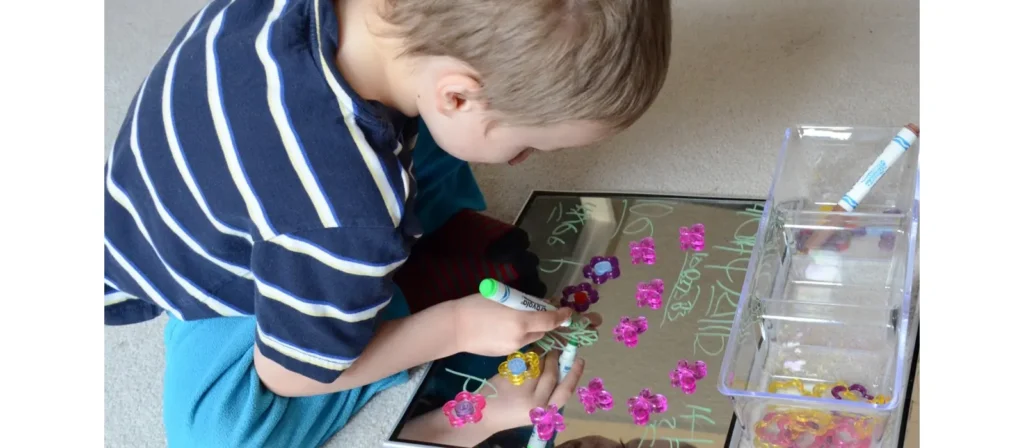
Steps
- Provide a washable mirror and safe, erasable markers.
- Ask the child to trace their reflection or draw over their facial features.
- Introduce shape drawing or symmetry challenges.
- Let them clean and restart for a new round.
Benefits
- Boosts creativity and fine motor skills.
- Encourages artistic expression.
- Reinforces self-recognition and spatial awareness.
6. Mirror Dress-Up Time
Children explore identity, imagination, and visual perception by dressing up in front of a mirror. They can try on different hats, glasses, scarves, or costumes, observing how their appearance changes and describing what they see.
Steps
- Provide a collection of dress-up items (hats, glasses, scarves, etc.).
- Let children choose and try on items in front of the mirror.
- Ask questions like “What do you look like?” or “Who are you pretending to be?”
- Encourage storytelling or role-play based on their appearance.
Benefits
- Enhances self-image and self-confidence.
- Encourages imaginative thinking and language use.
- Builds descriptive vocabulary and storytelling skills.
7. Symmetry Building Mirror Play
Children explore the concept of symmetry by building half of a structure with blocks in front of a mirror. The reflection creates a complete, symmetrical shape. This activity builds spatial awareness and introduces early math concepts like symmetry and reflection.
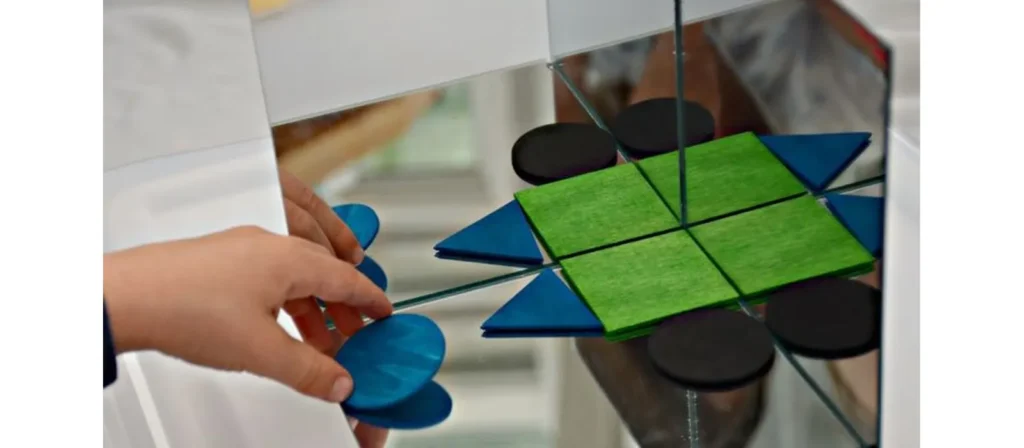
Steps
- Place a child-safe mirror vertically on a flat surface or table.
- Give the child a small set of colorful building blocks.
- Ask them to build a shape or pattern on one side of the mirror only.
- Observe how the mirror completes the other half to create a symmetrical image.
- Encourage experimentation with different shapes and block arrangements.
Benefits
- Develops early math skills (symmetry, geometry).
- Strengthens spatial reasoning and visual perception.
- Encourages creativity and problem-solving.
قم بتحويل فصلك الدراسي باستخدام حلول الأثاث المخصصة
خاتمة
Mirror play is far more than a moment of curiosity or amusement. From the first time an infant catches sight of their reflection to the complex pretend games of preschoolers, it offers a powerful path for growth. Through the mirror, children learn to connect movement with meaning, emotion with expression, and observation with understanding.
في شيها كيدز, our range of Montessori Mirrors and classroom furniture is designed to meet the highest standards of safety, quality, and developmental value. From baby floor mirrors to wall-mounted exploration panels, each piece supports children to develop with confidence and joy.
